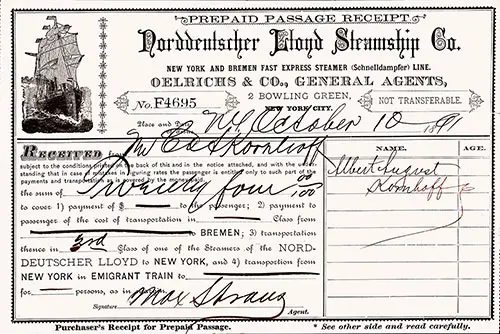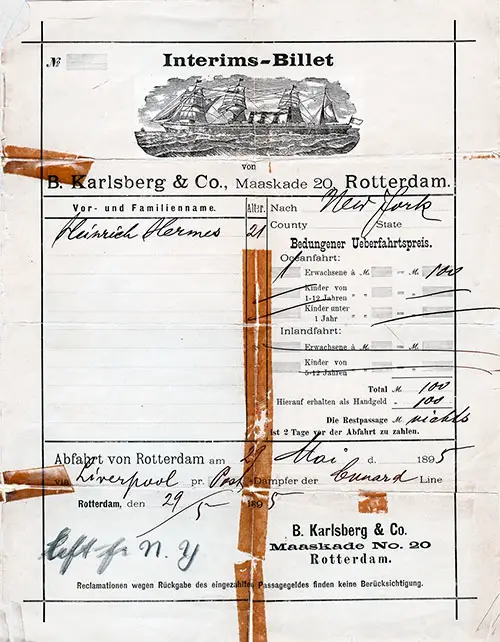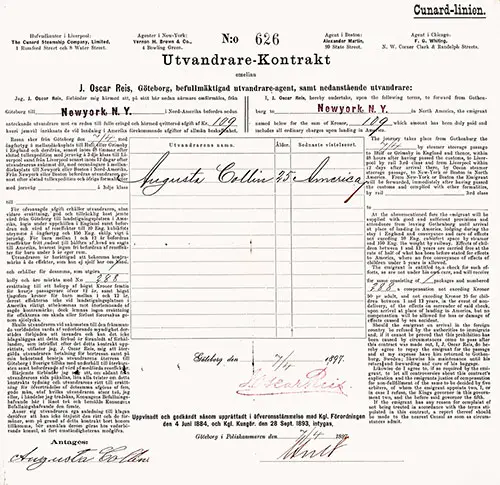Passage Contracts & Tickets (1890s) – Rare Immigration Records & Historic Ocean Travel Documents
📌 Explore original passage contracts and prepaid tickets from the 1890s, documenting immigrant journeys aboard historic steamships like RMS Lucania, SS Trave, and SS St. Louis. A must-have resource for genealogists, historians, and maritime enthusiasts tracing transatlantic migration, ticketing practices, and shipboard experiences. 🚢📜
All Passage Contracts and Tickets for the 1890s available at the GG Archives. These unique contracts represent primary source documents of the voyage of many immigrants. Our collection includes a variety of types and classes and provides an invaluable account of the cost of passage.
🚢 Passage Contracts and Tickets – 1890s: A Fascinating Look at Transatlantic Migration
📜 Overview: An Essential Archive of Immigrant Voyages
The GG Archives’ collection of 1890s passage contracts and tickets provides an invaluable window into the migration patterns of the late 19th century. These documents represent primary source records that help uncover the journeys of immigrants, business travelers, and settlers, offering essential details on ticket pricing, travel conditions, and prepaid passage systems.

SS Trave Prepaid Passage Receipt - 1891: A German Immigrant’s Journey to America
A Vital Piece of Immigration History
The SS Trave Prepaid Passage Receipt, dated October 10, 1891, is an exceptional artifact that sheds light on the prepaid ticket system, a crucial element in late 19th-century transatlantic migration. This receipt represents the financial and logistical process of assisted immigration, where family members or sponsors in the United States prepaid for relatives to join them.
This document is a goldmine of information—not just about one passenger, but about the broader migration patterns of German immigrants. It provides an authentic primary source illustrating how 19th-century emigrants navigated the complexities of ocean travel. It offers vital details about passenger names, ticket costs, and travel conditions, helping descendants piece together family stories.

RMS Lucania Passage Contract - 1895: A German Immigrant’s Journey to America
A Critical Historical Document on Ocean Travel and Immigration
This 1895 Steerage Passage Contract for Heinrich Hermes aboard the RMS Lucania of the Cunard Line provides an authentic look into late 19th-century transatlantic migration. As a German immigrant, Heinrich’s journey from Rotterdam to New York via Liverpool represents the millions of Europeans who crossed the Atlantic in search of a better life.
This document is a valuable resource that reveals the logistics of steerage travel, ticket pricing, and immigration records. It serves as a primary source for understanding transatlantic migration, the conditions of steerage class, and the economic realities of immigration. It offers a direct link to passenger manifests, ancestry records, and the financial sacrifices made by immigrants.

RMS Campania Passage Contract - 1897: A Swedish Immigrant’s Journey to America
An Essential Document for Understanding Transatlantic Migration
This 1897 Swedish Steerage Passage Contract for Augusta Collin, a 25-year-old Swedish servant, documents her journey from Gothenburg, Sweden, to New York via Hull and Liverpool aboard the RMS Campania of the Cunard Line. This contract provides a rich historical insight into the process, costs, and conditions of immigrant travel in the late 19th century.
This document is an authentic record of Swedish emigration, showcasing how European immigrants booked their voyages and the terms under which they traveled. It serves as a compelling primary source, illustrating the complexity of 19th-century migration, immigration laws, and the role of major steamship lines in transatlantic travel. It provides direct links to passenger manifests, immigration policies, and socioeconomic data on European migration.

SS St. Louis Prepaid Passage Memorandum (1897) – A Window into Transatlantic Travel
A Significant Document for Genealogists, Historians, and Ocean Travel Enthusiasts
This 1897 Prepaid Steamship Ticket Memorandum for J. L. Laplace, traveling Second Cabin aboard the SS St. Louis of the American Line, offers a fascinating insight into transatlantic travel at the turn of the century. The document provides valuable details about ticket costs, terms, refund policies, and the financial aspects of prearranged passage—all of which are crucial for understanding immigration, tourism, and business travel during this era.
This document showcases how transatlantic voyages were arranged, paid for, and structured, shedding light on Second Cabin travel—a class that bridged the gap between luxury and steerage. It serves as a real-world primary source that enhances discussions about migration patterns, social mobility, and the evolution of international travel. This document may be a missing link in family history research, offering proof of an ancestor’s voyage to America.

American Line Prepaid Passage Memorandum (1898) – A Rare Look at Transatlantic Travel
This 1898 Prepaid Passage Memorandum from the American Line provides a valuable historical perspective on how individuals traveled across the Atlantic in the late 19th century. Purchased for Second Cabin passage, this document represents one leg of a larger journey, possibly for business, relocation, or family reunification.
This document serves as an essential record of international movement, potentially linking to passenger manifests, census records, and family histories. It is a primary source that showcases how transatlantic travel was financed, arranged, and regulated. It provides insights into social class differences, economic conditions, and migration patterns during the late 19th century.
📌 Why is this collection important?
✔️ Authentic immigration records—detailing real names, origins, and destinations.
✔️ Provides insight into ticketing systems, travel classes, and ocean liner operations.
✔️ Essential for genealogy research, connecting families with historical migration records.
✔️ Examines transatlantic shipping companies like Cunard, Norddeutscher Lloyd, and American Line.
✔️ A crucial resource for understanding immigration laws, maritime travel, and socioeconomic conditions.
🚢 Each passage contract provides a direct link to history, documenting the realities of late 19th-century ocean travel.
🌍 Who Would Benefit from This Collection?
📖 Teachers & Students – Explores transatlantic migration, maritime history, and economic factors influencing travel.
🧬 Genealogists – Aids in tracing family roots, verifying migration paths, and confirming travel records.
📜 Historians – Offers a detailed look at immigration policies, maritime commerce, and travel logistics.
🛳 Maritime Enthusiasts – Reveals the operations of 19th-century ocean liners and the experience of passengers.
📜 Key Highlights from the Collection
Each passage contract in this collection presents unique insights into late 19th-century migration and ocean travel. Below are some of the most noteworthy cases:
🚢 SS Trave (1891): A German Immigrant’s Prepaid Voyage to America
🔹 Passenger: Albert August Komhoff
🔹 Route: Germany → New York
🔹 Why It’s Important:
✔️ Demonstrates how prepaid passage systems worked—relatives in the U.S. often paid for immigrants’ tickets.
✔️ Connects directly to U.S. immigration records, linking families to Ellis Island-era arrivals.
✔️ Offers an authentic record of Norddeutscher Lloyd’s role in transatlantic migration.
🚢 RMS Lucania (1895): A German Immigrant’s Steerage Passage to America
🔹 Passenger: Heinrich Hermes
🔹 Route: Rotterdam → Liverpool → New York
🔹 Why It’s Important:
✔️ Illustrates the realities of steerage-class travel, showing the economic struggles of immigrants.
✔️ Provides insight into the role of Cunard Line in European migration to the U.S.
✔️ A vital genealogical resource for tracing German ancestry and migration paths.
🚢 RMS Campania (1897): A Swedish Servant’s Journey to America
🔹 Passenger: Augusta Collin (Age 25)
🔹 Route: Gothenburg → Hull → Liverpool → New York
🔹 Why It’s Important:
✔️ A firsthand record of Swedish migration, highlighting the ticketing process and travel conditions.
✔️ Examines social class mobility—how immigrants from modest backgrounds sought better opportunities.
✔️ Demonstrates the role of Cunard Line as a major carrier of European migrants.
🚢 SS St. Louis (1897): A Second Cabin Prepaid Passage Memorandum
🔹 Passenger: J. L. Laplace
🔹 Route: Unknown → New York
🔹 Why It’s Important:
✔️ Provides insight into Second Cabin travel—offering more comfort than steerage but less luxury than First Class.
✔️ Details the financial aspects of ocean travel, including refund policies and prepaid tickets.
✔️ A key document for historians studying passenger class divisions and transatlantic business travel.
🚢 American Line (1898): A Prepaid Second Cabin Passage for Two Travelers
🔹 Passengers: Lloyd E. Brown & Leslie D. Brown
🔹 Route: Unknown → New York
🔹 Why It’s Important:
✔️ Showcases how prepaid tickets facilitated family migration and business travel.
✔️ Provides information on ticketing policies, refund options, and Second Cabin accommodations.
✔️ A critical genealogical record, connecting to passenger manifests and census data.
💰 Ticket Prices: Then vs. Now
💰 Late 1800s Ticket Prices: Ranged from $25 (steerage) to $50+ (Second Cabin).
💰 2020 Equivalent: Between $800 and $3,000, based on inflation adjustments.
📌 Did You Know?
✔️ Steerage passengers received basic meals and shared crowded living spaces.
✔️ Second Cabin travelers had more privacy, better dining, and slightly improved accommodations.
✔️ Prepaid tickets were a common way for families to afford passage.
🖼 Noteworthy Images in the Collection
🖼 📜 Original Passage Contracts – Rare surviving documents from 1890s transatlantic voyages.
🖼 🚢 Historic Ocean Liners – Featuring ships like RMS Lucania, SS St. Louis, and SS Trave.
🖼 📄 Passenger Records & Memorandums – Providing direct links to immigration and census records.
